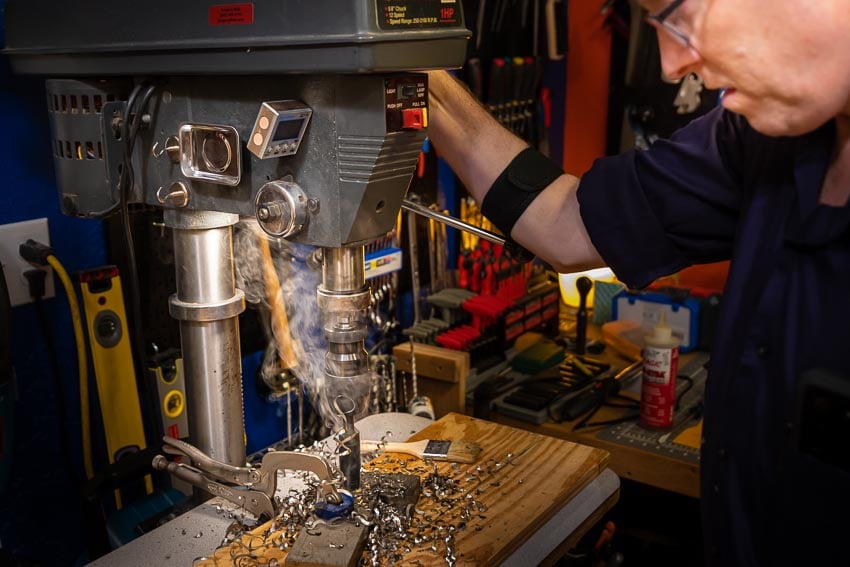So you have a piece of metal and it needs a few holes in it. No big deal you think. You grab your drill and a bit. Five minutes later when you have barely made a dent in the metal, you decide it is time to go to the hardware store for a new drill bit. After a few minutes, the tip of the new drill bit turns blue and you still haven’t finished your holes. You take it to a friend’s house. The guy that seems to know how to do everything. He drills all the holes in seconds. If this sounds familiar, read on to find out the techniques and tricks you need to know about how to drill through metal.
Table of Contents
- Starting the Hole (Finding Your Center)
- Drilling the Pilot Hole into Metal
- How to Drill Through Different Types of Metal
- The Right Bit Choices Determine How to Drill Through Metal
- Use Heat & Cutting Fluid When Drilling
- How to Vary Speed and Pressure to Drill Through Metal
- How to Drill Through Metal: Breaking Through
- How to Drill Through Metal – Cleanup
- Final Thoughts
Starting the Hole (Finding Your Center)
Before you can drill a hole in metal, you need to find your center and start the hole. Without this you likely won’t drill the hole exactly where you want it. This is typically done with a center punch or something called a prick punch. You’ve likely already used a center punch. You just place the point on the location you want to start the hole and strike the end with a ball-peen hammer.
It’s important not to use a claw hammer because they are hardened—and so is the center punch. Never strike a hardened tool against another hardened tool or you risk it chipping. Significant eye injuries are caused this way every year. This is why hammers always come with the warning to wear safety glasses.
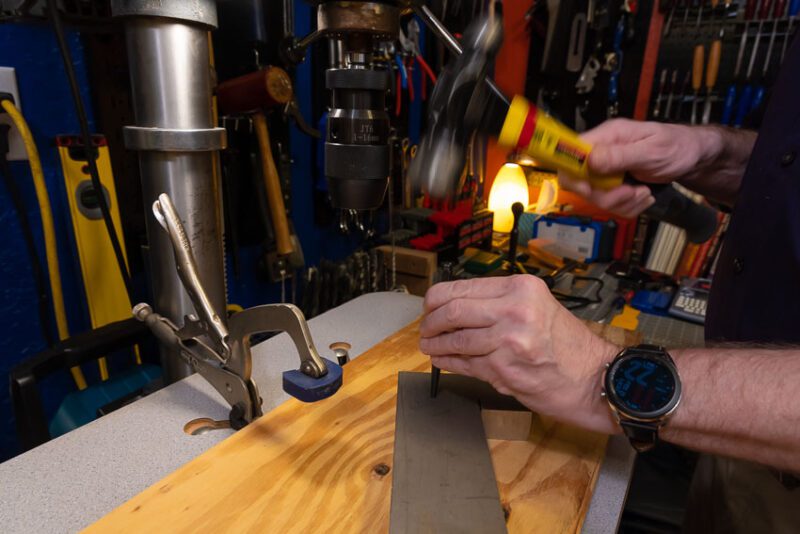
A prick punch is like a center punch except with a sharper point. Use it to locate a more exact point and then follow up with a center punch to make a deeper, wider hole. Note that the prick punch should only be used on mild steel and softer metals like aluminum so you don’t damage the point.
Many people swear by the automatic spring-loaded center punches favored by woodworkers. These are great in aluminum and other alloys. They will work in mild steel, but due to the fine point, they wear out faster than prick punches and center punches. To use them, simply line up the point and push down on the handle. An automatic internal mechanism triggers the punch.
Drilling the Pilot Hole into Metal
After locating a starting point for the bit, you want to drill a pilot hole. A pilot hole is a smaller hole for your final drill bit to follow. Pilot holes remove some of the material making it easier for the larger bits to bore straight through. When using my drill press, I skip pilot holes when drilling less than 1/2-inch in diameter. When using a hand drill, I make pilot holes for 3/8-inch and larger holes.
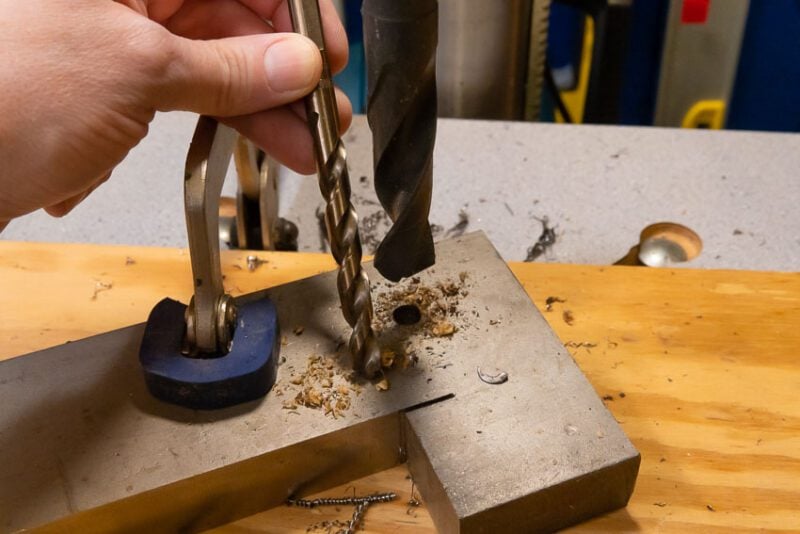
How to Drill Through Different Types of Metal
There are MANY different types of metal out there. Most of us typically use just a few: carbon steels like mild and stainless steels, aluminum, or alloys like brass or bronze. Machinists approach every metal differently and want to know the EXACT type of steel or alloy they are working with. They may specify 6061T6 aluminum for one part of a project and 3003H14 aluminum for another because of the stresses that particular joint needs to tolerate. They are often trying to achieve tolerances of 0.0001 or greater.
For the average person, think of three major categories: steel, stainless steel, and aluminum/alloys. If you run into issues from there, Google the specific metal you are using. Metals like titanium or armor plating take special techniques. Again, Google is your friend.
The Right Bit Choices Determine How to Drill Through Metal
There are many types of drill bits out there. We recently wrote an article on the best drill bits for metal. Below are the most important ones to have in your tool kit for metal.
High Speed Steel Twist Bits
High-speed steel bits or HHS bits cost less than many other metal drilling bits and you get what you pay for. When I was a young starving artist, I bought a set of cheap bits. The first time I used them in metal they literally unwound themselves. Ever since then I have bought Black & Decker Bullets, which are now branded as DeWalt drill bits with a pilot point. They work great in everything but the hardest metals like stainless steel.
I recommend titanium-coated bits for the best value in mild steels. Black oxide works well too and costs even less. The coating helps these bits perform better and last longer. The downside is that you cannot sharpen these bits when they get dull and maintain the coating.
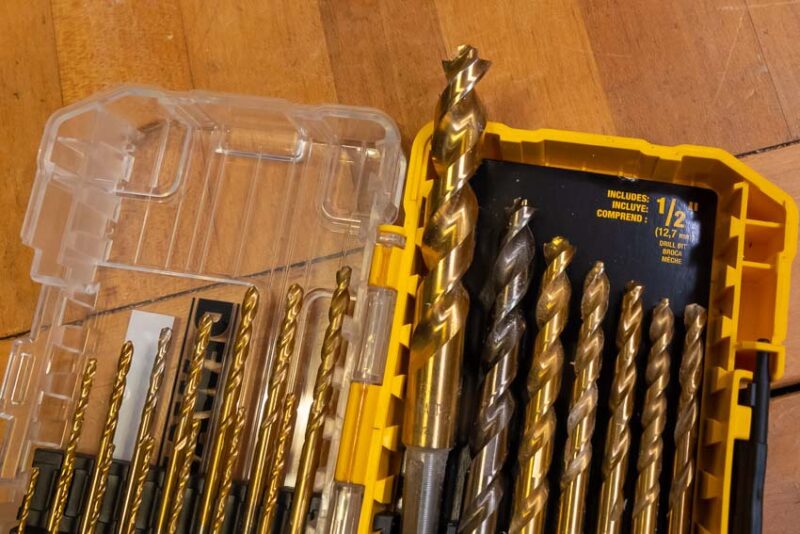
Most HHS twist bits come in several tip designs and usually in either 118-degree or 135-degree angles. While 118-degree bits used to be made for softer steels like mild steel, aluminum, and other alloys, some manufacturers are switching more bits to use 135-degree split tips. When you want to drill into harder metals like stainless steel, move on to cobalt bits.
Cobalt Drill Bits
Cobalt drill bits are twist bits with five to eight percent cobalt added to help them stay sharper longer and remain more heat tolerant. They look just like HHS bits, though the color may be a little different. It is important you don’t mix them up with your regular twist bits. They cost more than HSS bits as well, but you can sharpen them as the cobalt isn’t a coating but rather part of the metal itself.
I don’t use cobalt bits for wood or plastics. With a cutting angle of 135-degrees, they actually don’t cut those materials as well. It has been my experience that the DeWalt Pilot Point Bits will also drill through aluminum more quickly than cobalt bits. Where cobalt bits shine is their longevity in harder metals. They can keep cutting where other bits would have gotten dull and ceased to be productive.
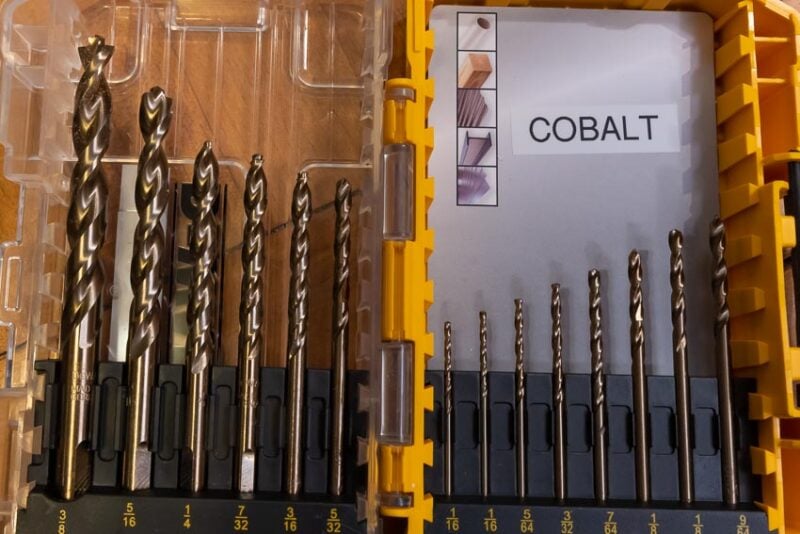
Silver and Deming Bits
A lot of people know how to drill holes up to 1/2-inch. The question remains, how do you drill through metal in larger diameters? The secret is Silver and Deming bits. They are named for the company that invented them and the name stuck no matter the manufacturer (kind of like Kleenex or Xerox). Most Silver and Deming bit sets can range from 1/2-inch up to 1-inch or even 1.5-inches. To stay safe, you should only use the larger sizes with a drill press and with the workpiece securely clamped down.
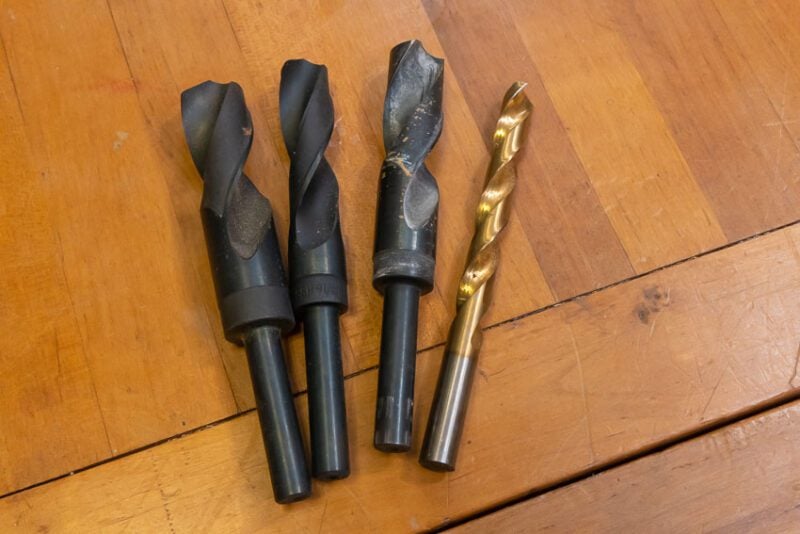
Step Bits
If you have never seen a step bit (also known as a unibit), they look like small metal Christmas trees. A single step bit can cut multiple hole sizes in thin metal. To use one, look at the scale on the inside of the cutter and see how many “steps” you need to feed the bit in to make the proper size hole. For instance, if you are using one that has ten steps to reach a 2-inch diameter hole, start your hole and carefully count the steps as you drill.
If the work is critical, stop at eight or nine steps and double-check the size of the hole. If you drill one step too many, you will ruin your workpiece. Also, make sure you use proper lubricant when drilling with step bits.
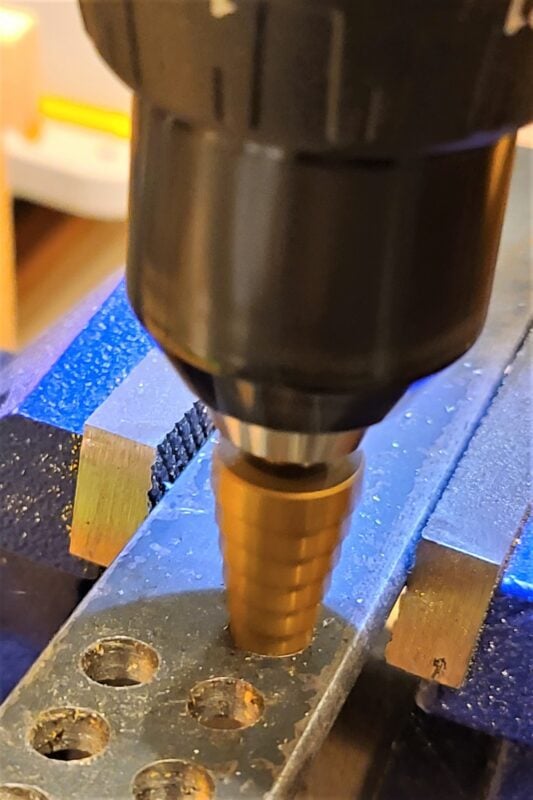
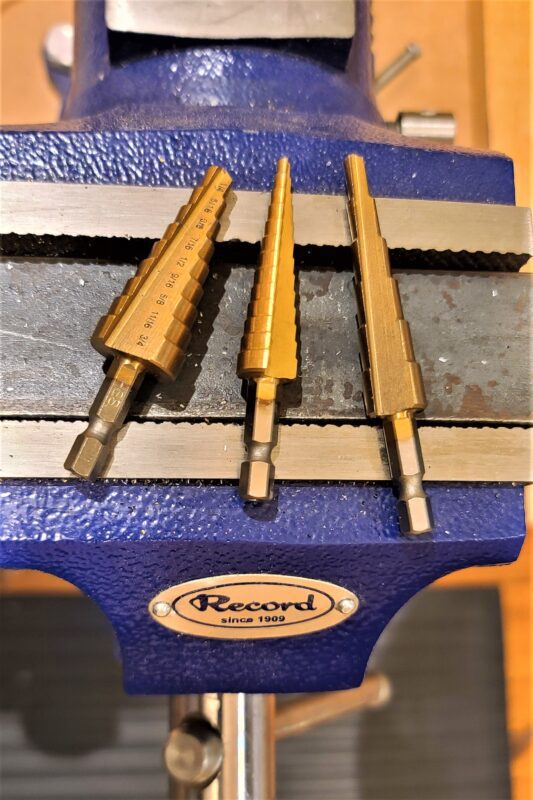
Drilling Holes in Metal Using Annular Cutters and Hole Saws
Annular cutters are like hole saws for metal. You can also use bi-metal hole saws for a few holes here and there in metal, especially in softer metals like aluminum. The experience is less than ideal, however. These saws are incredibly loud in metal and the hole saws wear out much more quickly. The task can also be rather dangerous if you don’t have the work clamped down to your drill press.
Once I was drilling 3-inch holes in aluminum tubing with a hole saw using a drill press. Unfortunately, I was inside a closed building. Someone from about 300 feet away came and asked me to stop because it was so loud, it made their teeth hurt. Imagine how I felt in the same room positioned just 3 feet away! Using hole saws on metal should only be done on very thin and tightly anchored sheet metal—like electrical panels. Drilling large holes in metal using a hand drill is just asking for an injury to your wrist.
Use annular cutters with a drill press. A tabletop drill press probably doesn’t have enough power to cut large holes in metal. This goes for either an annular cutter or a hole saw in metal. Annular cutters have more in common with milling machine mills than hole saws. They practically melt through any type of metal and are a joy to use.
Annular Cutters and Hole Saws Application and Pricing
Previously, annular cutters were extremely expensive. Now they are just moderately expensive. In the age of cheap Chinese tools, good quality sets can be found for less than $250 for a set of six that drill up to two inches in diameter. You will need a Morse Taper MT2 adapter for your drill press to be able to use annular cutters since most have 3/4-inch squared-off shanks for use in magnetic drill presses.
A magnetic drill press features powerful electromagnets on the base that lets it stick to ferrous metals like I-beams. They will even maintain their grip upside down. As you can guess, if the power goes out, or someone kicks the power cord, the tool comes crashing down to the ground. It is therefore critical that they be strapped down or tethered as a backup. Just a word of warning, the second time I used one I erased all my credit cards, so now I keep my wallet well away from these tools!
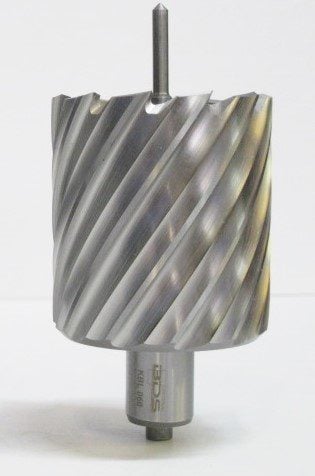
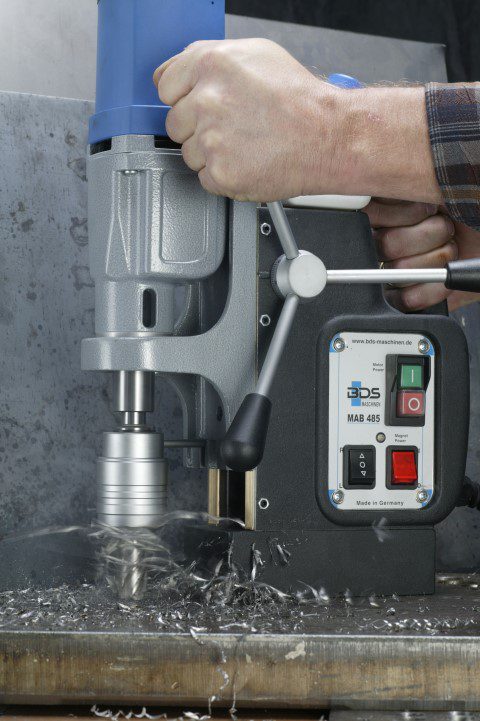
Use Heat & Cutting Fluid When Drilling
Once you’ve chosen your drill bit, you need to do one thing to make the bit last as long as possible—keep it cool. Cutting fluid helps remove the heat and flush away chips/shavings. Anytime I drill or cut metal, I add cutting fluid. This can be as easy as dripping some on the metal and bit before and during the drilling or cutting process.
One of the best ways to apply it is with a chip brush in a container of cutting fluid you keep around specifically for this task. In machine shops, their equipment has hoses, nozzles, and pumps that constantly spray cutting fluid/coolant onto the bit and workpiece. Drill and cut cast iron with no cutting fluid as it is the exception.
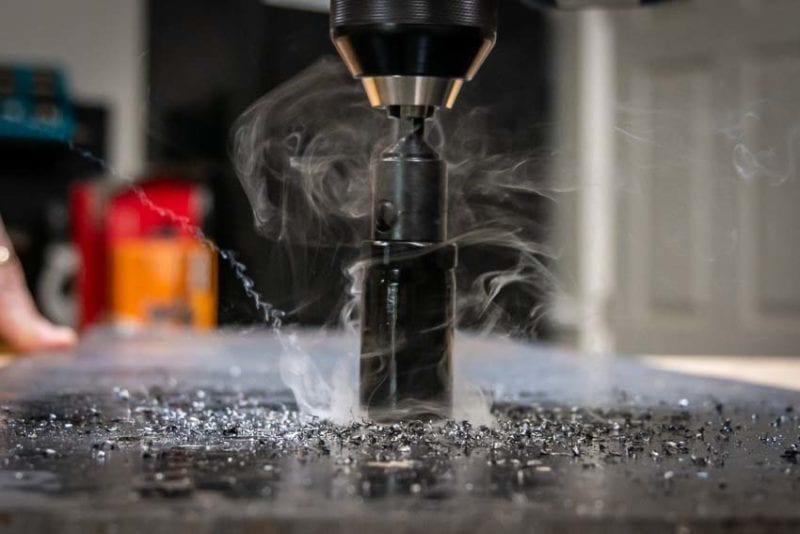
A variety of cutting fluids exist on the market today. Years ago folks would even use bacon grease! Not in my shop as I don’t want to attract roaches, rodents, or my dog (Editor’s note: Plus we know oif better uses for bacon grease!). Some people use 3-in-1 oil or even WD-40. I use WD-40 a lot when I am away from my shop and have to drill metal because I always have some in my truck. Now we have modern cutting fluids which are much more effective. My favorite is Tap Magic cutting fluid. If you use a lot of aluminum, Tap Magic makes cutting fluid specifically for aluminum. Beeswax also works great for aluminum but that may be harder to locate.
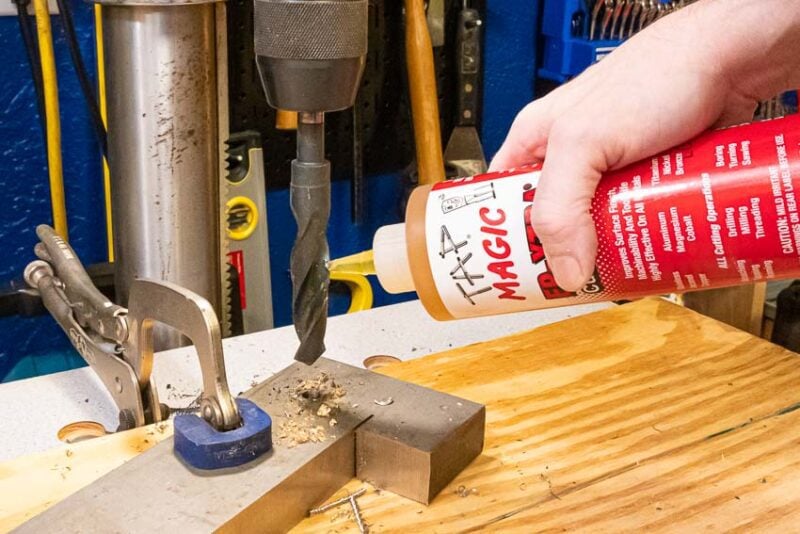
How to Vary Speed and Pressure to Drill Through Metal
Until now, we’ve talked about what you need to drill a hole in metal. This next part of how to drill through metal is entirely technique.
Technique makes all the difference.
The speed of your drill bit and how much downward force you apply to the bit is truly where the skill comes into play that will help you be successful in drilling metal.
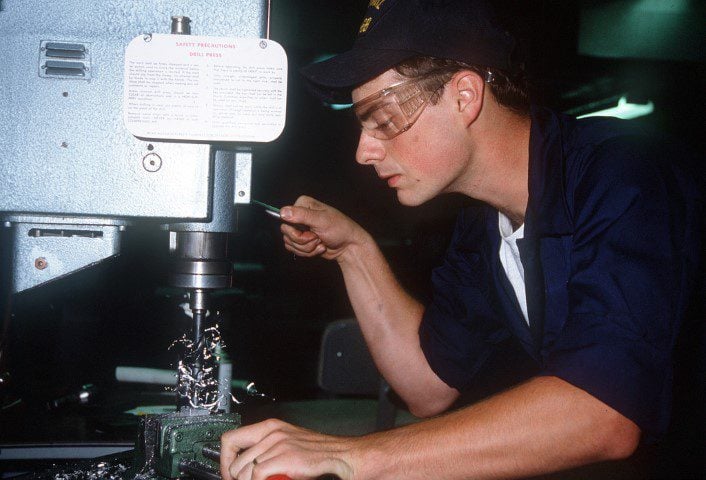
First, let’s talk about drilling speed. As a rule of thumb, go S-L-O-W. On your hand drill, put it in Low gear (often represented by the number 1). On a drill press, slow it way down. More accurately though, there are numerous drilling speed charts on the Internet that will tell you exactly what speed you need to set your drill at for which material, and which size and type of bit you are using. Most hand drills will not set the speed this accurately, but drill presses will. When in doubt, you can’t go wrong drilling metal at the slowest speed your drill will run. It may not be the most efficient way to drill, but it will work without damaging the bit.
As far as pressure goes, the shavings will tell you whether you are doing it right. If you get dust or tiny flakes of metal, you are not pushing hard enough for the bit to cut properly. You know you are using the correct amount of pressure when you create long continuous shavings—several inches long. I often get shavings a foot long. Since they are so long, they eventually break off and whip around in the air. Safety glasses are a must.
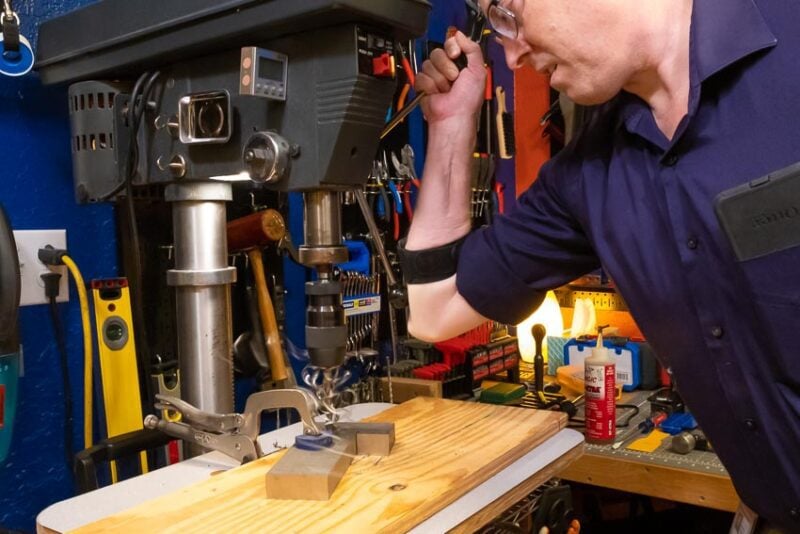
How to Drill Through Metal: Breaking Through
The most dangerous part of drilling a hole in any material, but especially metal, is when you finally break through. Therefore, when you get close to coming out the other side, slow down and ease off the pressure. Hang on very tightly to the workpiece (if it’s not clamped down). There is a good chance the bit is going to grab it and try and yank it out of your hands. That is why it is so important to always clamp down the workpiece. It makes for an “exciting” time when you have a chunk of steel spinning around at 300 RPM trying to break something!
How to Drill Through Metal – Cleanup
After finishing your hole, resist the urge to sweep your hand across the workpiece to clear the metal shavings as you might do with wood. If you do, your hand will be itching for a week because of micro-cuts to your skin. Instead, use a chip brush. This is how they got their name! They are not meant to be paintbrushes. Chip brushes are for brushing metal chips away in machine shops.
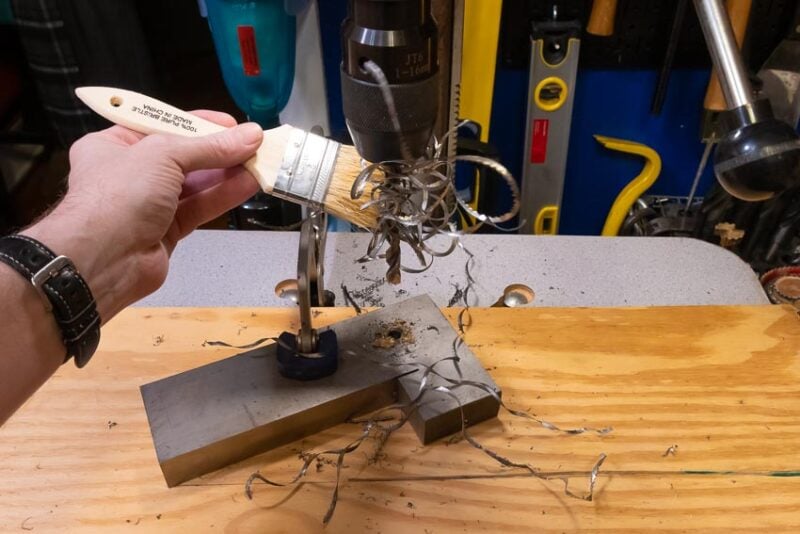
After you clean up the drill press, also clean the floor and the bottom of your shoes. You don’t want to track metal chips through adjoining rooms. It is very painful to step on them barefoot and you never get them out of the carpet. You just keep stepping on them. Ask me how I know!
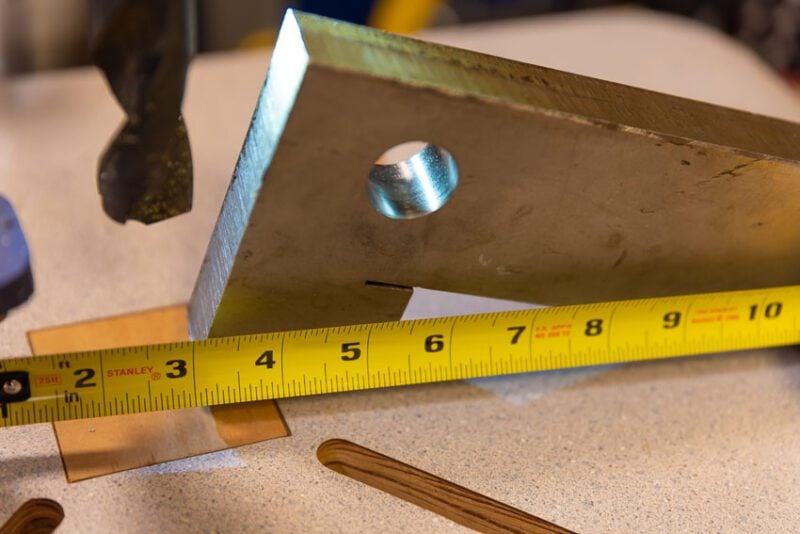
Final Thoughts
Learning how to drill through metal is not that hard. If you are using a sharp bit with the right speed, pressure, and a good cutting fluid, your shaving will come out 6-inches or longer. That is when you know you’re doing everything just right and drilling holes in metal becomes a pleasure…though still a bit messy.

